The beginning of a new year came as a signal of hope to many after living the realities of 2020. After a bumpy start amid slow vaccine rollouts, political uncertainty, and doubts in the swiftness of an economic recovery, investor sentiment turned more positive as a stream of promising economic data and solid fourth quarter corporate reports powered
U.S. equities to strong gains in the first quarter of 2021. Markets were also aided by a decline in new COVID-19 cases and hospitalizations, the passage of a $1.9 trillion fiscal relief bill, and the Federal Reserve’s reassurances that it would maintain its near-zero interest rate policy and monthly bond purchase program. With 99% of the companies in the S&P 500 index reporting, 79% reported a positive earnings surprise, with just 17% reporting earnings below consensus estimates.1
The stock market climb was not without its hiccups including inflation concerns, a sharp and rapid rise in bond yields, and market reactions to comments made by Fed Chair Jerome Powell. Technology shares and those of other high-growth companies experienced some of the biggest downdrafts as investors appeared to rotate into more economically sensitive stocks.
Markets advanced higher, but trading turned choppy toward the end of Q1. Traders digested the outsized gains from the pandemic lows, and institutional investors and pension plans underwent their quarterly rebalancing. Nevertheless, stocks closed near their highs as the quarter ended.
ECONOMIC CONDITIONS: Vaccine Dependent – U.S. – Leading the Recovery GDP
Despite harsh winter weather in February that led to a slowdown in consumer spending and manufacturing activity, early indications suggest a robust growth rate in the first three months of 2021. While we will not know for sure until April’s release of the Q1 GDP (Gross Domestic Product) report, the Federal Reserve Bank of Atlanta’s model is pointing toward a 4.7% real rate GDP growth in the first quarter. 2
UNEMPLOYMENT: In contrast with the positive GDP economic narrative, the labor market is more of a mixed picture. While the unemployment rate has come down from its elevated levels in 2020, improvement has slowed. The unemployment rate for February 2021 was 6.2%, a modest decline from its December 2020 rate of 6.7%.7 The number of Americans that remain unemployed stands at 10 million, while new jobless claims hover at stubbornly high levels. For example, the 770,000 new jobless claims reported for the week ending March 13 was above the four-week moving average of 746,250. 8,9
HOUSING: Existing home sales continue to be strong amid mortgage rates that remain at historically low levels. In March, the median home listing price reached an all-time high of $370,000, up 15.6% compared to last year. Large metro areas saw an average price gain of 12.1% compared to last year.
INTERNATIONAL: Speedbumps
The economic recovery in the European Union (EU) was hampered by a third wave of COVID-19 infections and lockdowns in the first quarter. The failure of its vaccination rollout in member nations was a major contributing factor for its lagging recovery when compared to the U.S.
It is estimated that the GDP of the EU will shrink by 0.4% in the first quarter. Despite this setback, the European Central Bank (ECB) maintains that the region’s economy remains on track to grow by 4.0% in 2021. This forecast, the ECB admits, is highly conditional on making progress in vaccine distribution efforts and a reopening of member nations’ economies.11,12 China fared better than most countries in getting its economy moving again as evidenced by its jump in industrial output in January and February of 2021: almost 17% over pre-pandemic numbers from the same period in 2019. Retail sales soared by 33.8%, though unemployment did tick up. 13 Amid a third lockdown in the United Kingdom, the Bank of England expects the U.K. economy to shrink in the first quarter by 4%. However, thanks to a COVID-19 vaccination rollout that is gathering steam, they are optimistically predicting growth of 7.25% in the U.K. in 2021.
EQUITIES: Pricing in Recovery
U.S. EQUITIES: As mentioned above, positive earnings and economic data drove the three major U.S. exchanges to all-time highs in Q1. In the wake of a major leadership change, the Dow Jones Industrial Average demonstrated a return of 7.76%, the S&P 500 rose 5.77%, and the Nasdaq lagged with a 2.78% return after an impressive 2020.
DEVELOPED INTERNATIONAL EQUITIES: International developed markets cooled off a bit after a blistering year end that saw a return of more than 17%. The FTSE All Country World ex US Index added a modest 3.71% in Q1.
EMERGING MARKETS: Emerging markets felt the impact of a rising dollar and weak global economic growth. The MSCI-EM (Emerging Markets) Index rose a modest 1.95%.
FIXED INCOME: Rates Moving Higher
U.S. FIXED INCOME: The U.S. bond aggregate index fell as interest rates rose, dropping more than 3.5%. The 10-year Treasury yield rose from under 1% at the start of the year to almost 1.75%. High yield bonds were relatively flat as appetite for risk narrowed spreads slightly.
DEVELOPED INTERNATIONAL FIXED INCOME: Rates continued to move higher overseas as the recovery from lows seen in March continued. The Global Aggregate Index lost 2.22% during the quarter.
QUARTERLY FOCUS: Inflation Alert
As the world continues to recover from the pandemic, consumers and producers have seen a surge in prices over the last few months as significant fiscal and monetary support from the government, diminishing COVID lockdowns, and accelerating vaccinations have rejuvenated economic activity. The federal government’s consumer price index (CPI), which measures the change in what consumers pay for goods and services such as groceries, clothing, and gas, increased 2.6% in March compared to a year ago, according to the Labor Department. The chart on the right from JP Morgan gives us a view of the average annual rate of inflation over the last fifty years. In more recent years, we can see that the inflation rate has jumped around 2%. After a year during which a large part of spending activity was suspended, we are now seeing an impressive reflationary impulse as consumers are eager to get out of the house and get back to some form of normalcy. The increase in activity is a welcome sight that is sure to lift prices of not only consumer goods but also stock prices as companies seek to meet rising demand for goods and services. This uptick in inflation is usually seen favorably as long as growth follows suit and inflation remains muted longer-term. The Fed sets its own long-term inflation target somewhere around 2% as this seems to be the sweet spot for a healthy economy in most developed nations.


An inflation rate lower than 2% signals economic malaise and is typically a byproduct of low demand and stagnant growth. Alternatively, inflation rates over 2% can choke growth as higher input costs as well as higher interest rates increase the overall cost of doing business. While there is general consensus that we will see a jump in inflation over the next few quarters, there is growing concern that we may see a non-transitory, persistently higher level of inflation du e to the vast amounts of money pumping into the system, thus creating a less attractive environment for growth. While upside inflation risks from a variety of sources exist, such as employments gains and higher energy prices, most base case projections expect a moderation of inflationary pressures as full employment remains elusive due to the continued digitalization an d automation of the workforce coupled with an aging U.S. demographic.

DPWM OUTLOOK
The Post-COVID recovery continues as global central bank support remains at an unprecedented level. The population as a whole, sits in a relatively strong financial position with an eagerness to get out and spend. The resulting uptick in growth and inflation should lift prices of all kinds – from table salt to stocks. The chart to the right by JP Morgan shows how various asset classes have performed during a period of low but rising inflation – which is where most economists think we are now (as measured by CPI). At the portfolio level, changes in inflationary environments can have broad impacts not only among assets classes (stock, bonds, alternatives) but within asset classes (value vs growth stocks). Let’s assume that we are currently in the bottom right quadrant – a time of low but rising inflation. This period tends to favor equities of all types, as well as alternatives such as real estate and commodities. Less favorable investments are cash (as interest rates are generally low) and bonds (which face lower prices if interest rates rise due to higher growth and inflation). While it is always a moving target, the current period of rising inflation and higher growth is expected to continue at least for the next few quarters. Using this as our base case scenario, DPWM portfolios remain in a position that benefits from that view. At an asset class level, in fixed income we remain defensive against rising rates with short duration bonds and higher yields. In equities, we favor cyclical groups such as emerging market, value and small caps. Finally, our alternatives are skewed toward assets and styles (i.e., real estate, materials and commodities) that should benefit from these inflationary impulses that we are likely to see over the next few quarters. Rarely do projections play out exactly as planned, but our portfolios are positioned to benefit should some of our inflationary expectations become reality.
CITATIONS:
1. Factset.com, March 5, 2021
2. frbatlanta.org, April 1, 2021
3. tradingeconomics.com, April 1, 2021
4. tradingeconomics.com, April 1, 2021
5. federalreserve.gov, April 1, 2021
6. wsj.com, February 17. 2021
7. statista.com, March 11, 2021
8. bls.gov, April 2, 2021
9. dol.gov, April 1, 2021
10. cnbc.com, March 17, 2021
11. ecb.europa.eu, April 2, 2021
12. ecb.europa.eu, April 2, 2021
13. bbc.com, March 15, 2021
14. news.sky.com, February 4, 2021
15. cnbc.com, March 23, 2021
PAST PERFORMANCE IS NOT A GUARANTEE OF FUTURE RESULTS.
The information, analysis, and opinions expressed herein are for general and educational purposes only. Nothing contained in this commentary is intended to constitute legal, tax, accounting, securities, or investment advice, nor an opinion regarding the appropriateness of any investment, nor a solicitation of any type. All investments carry a certain risk, and there is no assurance that an investment will provide positive performance over any period of time. Investors should consult with an investment advisor to determine the appropriate investment vehicle. Investment decisions should always be made based on the investor’s specific financial needs and objectives, goals, time horizon and risk tolerance. The statements herein are based upon the opinions of Denver Private Wealth Management (Denver PWM) and third party sources. Information obtained from third party resources are believed to be reliable but not guaranteed. All opinions and views constitute our judgments as of the date of writing and are subject to change at any time without notice. Denver Private Wealth Management offers Investment Advisory
Services through Vista Private Wealth Partners LLC, a separately SEC registered investment advisor.

Denver Private Wealth Management is an independent fee-based financial planning practice with 80+ years of experience in the financial industry. DPWM customizes portfolios based on your financial goals and works closely with you, your tax advisors and estate attorneys to form a comprehensive view of your financial situation. For more information or to set up a free consultation, contact us at info@denverpwm.com.
Post Disclaimer
The information contained in this post is for general information purposes only. The information is provided by Q1 2021: Powering Ahead and while we endeavour to keep the information up to date and correct, we make no representations or warranties of any kind, express or implied, about the completeness, accuracy, reliability, suitability or availability with respect to the website or the information, products, services, or related graphics contained on the post for any purpose.


 Tim Kulick, CPA®
Tim Kulick, CPA® Drew Kelleher, CFP®
Drew Kelleher, CFP®


